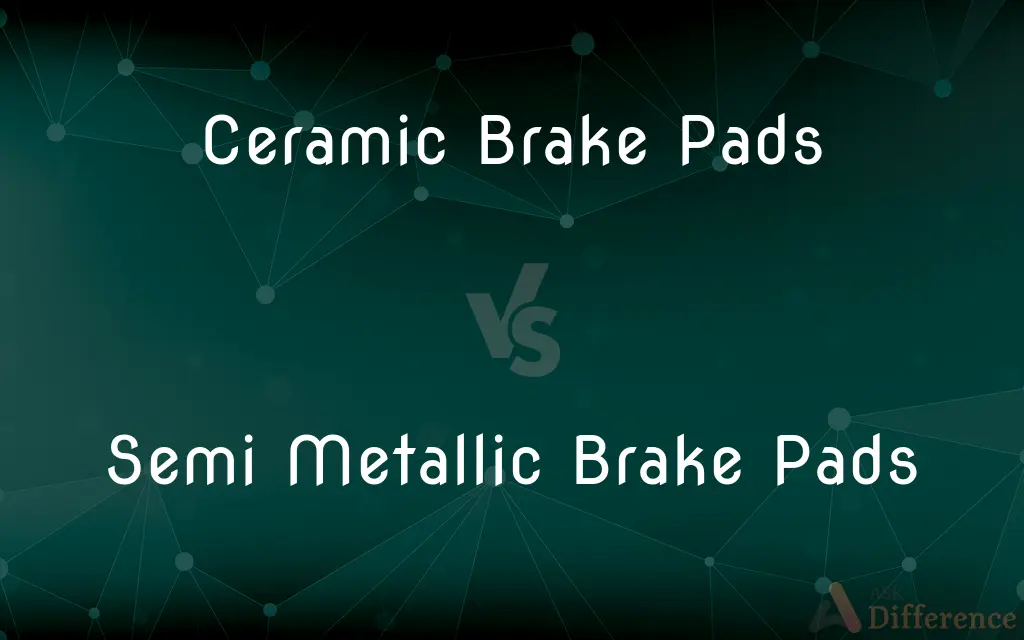Ceramic Brake Pads vs. Semi Metallic Brake Pads — What's the Difference?
By Urooj Arif & Fiza Rafique — Published on February 26, 2024
Ceramic brake pads offer quieter operation and less wear on brake rotors but may have higher costs and lower performance. Semi-metallic brake pads provide excellent heat dissipation and stopping power, especially in demanding conditions.

Difference Between Ceramic Brake Pads and Semi Metallic Brake Pads
Table of Contents
ADVERTISEMENT
Key Differences
Ceramic brake pads are made from a blend of ceramic fibers, bonding agents, and sometimes small amounts of metal. They are known for their durability, quiet operation, and minimal dust production, making them a popular choice for daily driving in standard conditions. Ceramic pads tend to perform well in a wide range of temperatures but might not offer the best performance in extreme cold or high-performance driving situations due to their moderate heat tolerance.
Semi-metallic brake pads, consisting of a mixture of metal shavings (such as steel, iron, or copper) and filler materials, are valued for their excellent heat dissipation and superior braking performance, particularly in heavy-duty or high-performance applications. These pads are more effective in transferring heat away from the brake rotors, reducing the risk of brake fade during intense use. However, the metallic content in these pads can lead to increased rotor wear and more noticeable brake dust compared to ceramic pads.
Ceramic pads are generally preferred for their quiet operation and cleaner wheels, suitable for the majority of passenger cars and light-duty vehicles. Semi-metallic pads, with their robust performance, are often chosen for vehicles subject to more rigorous driving conditions, such as towing, heavy loads, or performance driving, where the brake system's ability to handle high temperatures is crucial.
The choice between ceramic and semi-metallic brake pads depends on the vehicle's requirements, driving conditions, and driver preferences regarding performance, noise, and maintenance.
Comparison Chart
Composition
Ceramic fibers, bonding agents, some metal
Metal shavings (steel, iron, copper), filler material
ADVERTISEMENT
Noise Level
Quieter operation
Can be noisier
Dust Production
Less brake dust
More brake dust
Wear on Rotors
Less abrasive, gentler on rotors
More abrasive, can increase rotor wear
Performance
Consistent in various temperatures, not optimal for extreme conditions
Excellent stopping power, performs well in high heat and extreme conditions
Cost
Generally higher cost
Typically less expensive than ceramic
Best Used For
Daily driving, standard conditions
High-performance, heavy-duty applications
Compare with Definitions
Ceramic Brake Pads
Made with ceramic compounds and fibers.
Ceramic brake pads are favored for their quiet braking and minimal dust output on most passenger cars.
Semi Metallic Brake Pads
Tend to be noisier and produce more brake dust.
The increased brake performance came with the trade-off of more noise and dust from the semi-metallic pads.
Ceramic Brake Pads
Higher initial cost but can offer long-term value.
The upfront cost of ceramic brake pads was offset by reduced maintenance and longer service intervals.
Semi Metallic Brake Pads
More effective in extreme driving conditions or with heavy loads.
For the heavy-duty towing job, semi-metallic brake pads were the preferred choice for their resilience and reliability.
Ceramic Brake Pads
Known for smooth and quiet operation.
After switching to ceramic brake pads, the annoying brake squeal was no longer an issue.
Semi Metallic Brake Pads
Composed of metal shavings and other materials.
Semi-metallic brake pads, with their high metal content, are a go-to for performance enthusiasts.
Ceramic Brake Pads
Perform well in a range of temperatures but may falter in extreme cold or high-performance use.
Ceramic pads provided reliable stopping power in city driving, though their performance dipped slightly on the winter track day.
Semi Metallic Brake Pads
Excellent heat dissipation qualities.
The semi-metallic pads maintained their stopping power even under the high heat generated by spirited mountain driving.
Ceramic Brake Pads
Less abrasive on brake rotors.
Ceramic brake pads contribute to longer rotor life due to their gentle composition.
Semi Metallic Brake Pads
Generally more affordable but may lead to higher rotor wear.
While the semi-metallic pads were less expensive, they necessitated more frequent rotor checks and replacements.
Common Curiosities
Can I use ceramic brake pads for racing?
Ceramic brake pads are not usually recommended for racing due to their moderate heat tolerance compared to semi-metallic or racing-specific pads.
Do ceramic brake pads work in the rain?
Yes, ceramic brake pads perform consistently in wet conditions, maintaining effective stopping power.
Which brake pads last longer, ceramic or semi-metallic?
Ceramic brake pads typically last longer in normal driving conditions due to their less abrasive nature on rotors.
Do semi-metallic brake pads stop faster than ceramic?
Semi-metallic pads often provide superior stopping power in demanding conditions due to their composition and heat dissipation properties, but the difference may not be significant in everyday driving.
Why are semi-metallic brake pads preferred for heavy-duty use?
Their excellent heat dissipation and robust performance under high stress make them suitable for heavy-duty applications like towing or performance driving.
Can I switch from semi-metallic to ceramic brake pads?
Yes, you can switch between pad types, but ensure compatibility with your vehicle's braking system and consider how the change might affect braking performance.
Are semi-metallic brake pads bad for rotors?
Semi-metallic pads can be more abrasive on rotors, potentially leading to faster wear, but they offer superior performance in demanding conditions.
Will ceramic brake pads improve my fuel efficiency?
While brake pads have minimal direct impact on fuel efficiency, ceramic pads' lighter weight and reduced drag can contribute slightly to improved fuel economy.
Are ceramic brake pads worth the extra cost?
For drivers prioritizing quiet operation, reduced dust, and less frequent maintenance, ceramic brake pads can offer good long-term value despite their higher initial cost.
How do I choose between ceramic and semi-metallic brake pads?
Consider your driving habits, vehicle type, performance needs, and preferences regarding noise, dust, and maintenance when choosing between the two pad types.
Share Your Discovery

Previous Comparison
IMAX vs. Dolby
Next Comparison
Carpenter Ants vs. Black AntsAuthor Spotlight
Written by
Urooj ArifUrooj is a skilled content writer at Ask Difference, known for her exceptional ability to simplify complex topics into engaging and informative content. With a passion for research and a flair for clear, concise writing, she consistently delivers articles that resonate with our diverse audience.
Co-written by
Fiza RafiqueFiza Rafique is a skilled content writer at AskDifference.com, where she meticulously refines and enhances written pieces. Drawing from her vast editorial expertise, Fiza ensures clarity, accuracy, and precision in every article. Passionate about language, she continually seeks to elevate the quality of content for readers worldwide.
















































